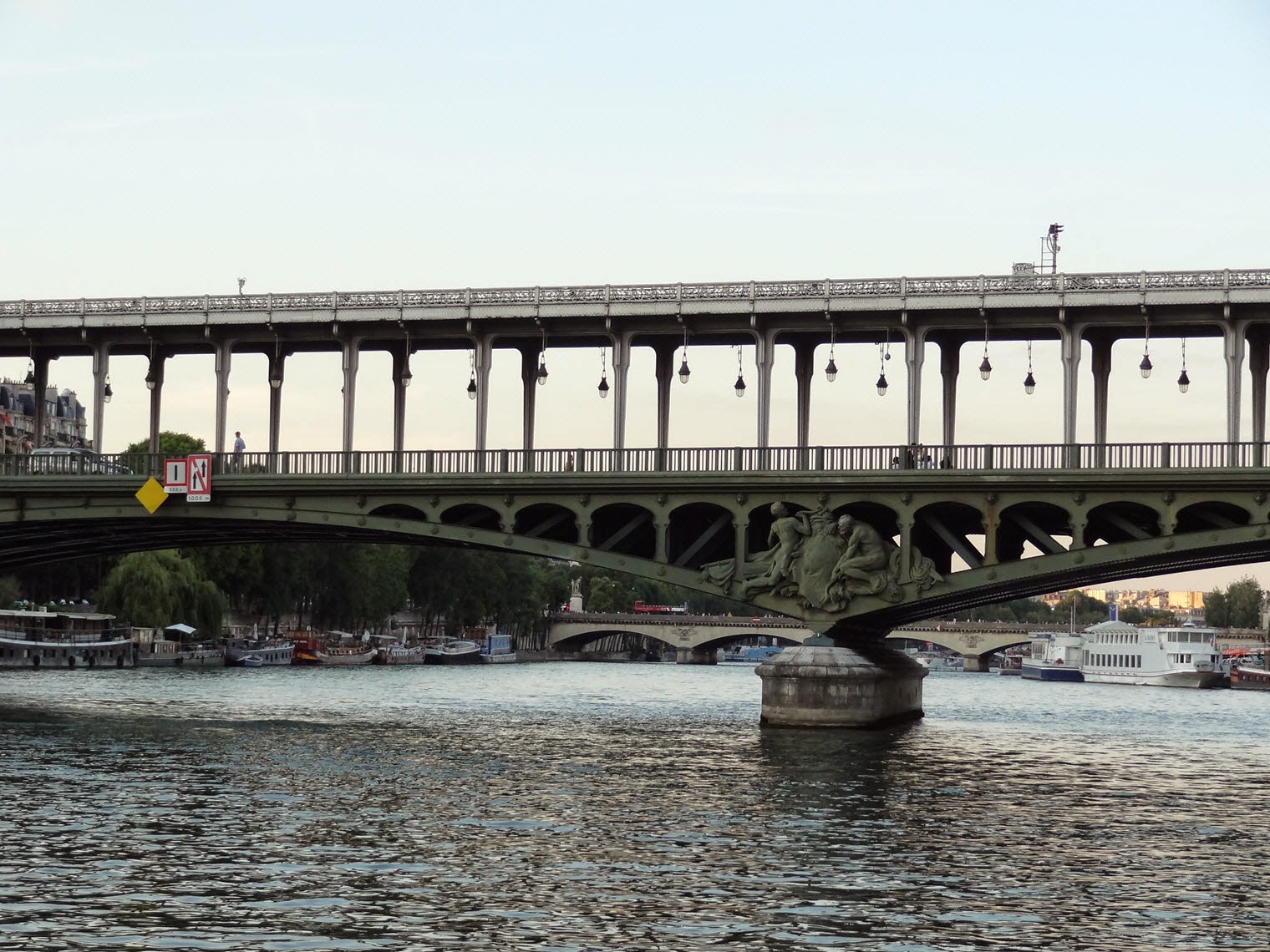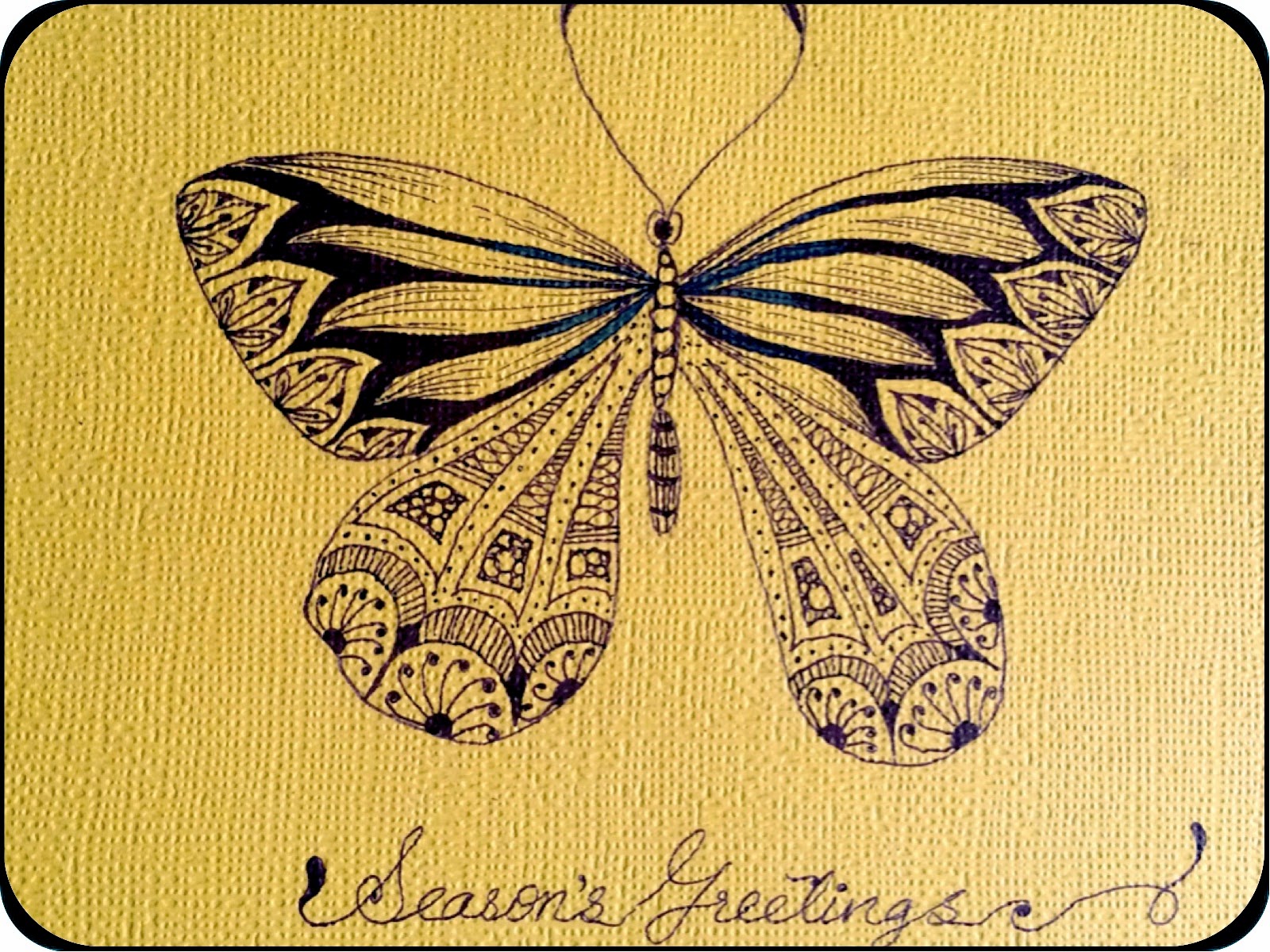The Siene divides Paris into the Left and Right Bank and with many monuments alongside, a cruise down the river is the fastest way to take in the City of Lights.
Bateaux-Mouches is one of the best known service providers and offers plenty of cruising options. They have a dinosaur skeleton sculpture near the ticketing office and you can play around trying to take a picture of it from different angles.
Apart from the buildings and Parisian life you see on either bank, the 776 km long river is known for its with 32 bridges within Paris. If you do have the time, it is worth your while to take a walk over some of these and get a closer look at some of the details and sculptures that adorn it. Here's a list of some of them we saw from the ferry (from upstream to downstream).
Text sources:
Wikipedia,
Paris Pages
The Pont de Sully is actually two separate bridges and was opened in January 1838. It was originally a pair of pedestrian suspension bridges, constructed by the engineer Surville. The current bridge was constructed in 1876 and named in honour of Maximilien de Béthune, Duke of Sully and minister to Henry IV. It was designed by the engineers Paul Vaudrey and Gustave Brosselin. You get splendid views of the Île Saint-Louis and Notre Dame.
Pont de la Tournelle was built by Paul Landowski and was put in place in 1928, though the bridge dates from 1620, marking what would have been the eastern limit of the fortifications in the middle ages. The statue on the bridge is of St. Genvieve, patron saint of Paris. Genvieve is facing east, which is the direction Attila and the Huns were approaching Paris from when she persuaded the people not to flee. It is also the direction most invaders approach the city. However Landowski, who had fought on the Somme in WWI, would have preferred Genvieve to face Notre Dame, and to represent peace. You can get wonderful views of the back of Notre Dame from this bridge.
The Pont Marie derives its name from the engineer who built it, Christophe Marie. Its construction was spread out over 20 years, from 1614 to 1635. Thus, the bridge is one of the oldest bridges in Paris. In a flood in 1658, 20 houses that were built atop the structure were destroyed and caused the deaths of 60 people. In 1660 a wooden bridge was rebuilt on the same spot, this time with a toll-booth which was designed to raise funds for the complete, stone renovation of the structure. This reconstruction was completed in 1670. In 1740, the remainder of the buildings atop the Pont Marie were removed and in 1769 all building atop the bridge was forbidden. In 1788, houses were barred from construction atop bridges throughout the city. Since the 18th century, the structure has seen little change aside from the flattening of its rise which did not alter the appearance. It is interesting to note each of the five arches of the Pont Marie is unique and that the niches in the abutments have never been filled with statues.
Pont au Double was fist built in 1634 and had a glass gallery, and the patients from the Hotel-Dieu (the oldest hospital in Paris) used it as a nice walk between the Ile de le Cite part of the hospital and the Left Bank part of the hospital. The bridge got its name because non-patients had to pay a double farthing to cross. Although other sources say that the name comes from horsemen having to pay double the toll of pedestrians. The present bridge dates from 1882.
The Petit Pont (Little Bridge) was built in 1853 and is notable for having been destroyed at least 13 times since its original inception. The bridge rebuilt under the reign of Charles VI consisted of three arches and lasted from 1398 until 1408. Designed by the architect Alexandre Michal, and built by Ernest Gariel, the present Petit Pont was begun in 1852 to provide more adequate clearance between the water and the bridge. Thus, the three arches were reduced to one. This new bridge was opened to traffic in 1853
Pont Neuf is considered the oldest bridge in Paris but it actually means new bridge, is actually the oldest bridge in Paris. It dates from 1578. Towards the end of the reign of Louis XVI all the houses on the bridges over the Seine were pulled down. Pont Neuf was the first stone bridge in Paris, the first with pavements, and the first to be built without houses.
Pont Des Arts differs from many other bridges in that it is constructed of metal and is entirely pedestrian. Between 1802 and 1804, under the reign of Napoleon I, a nine-arch metallic bridge for pedestrians was constructed at the location of the present day bridge and was the first metal bridge in Paris. The engineers Louis-Alexandre de Cessart and Jacques Dillon initially conceived of a bridge which would resemble a suspended garden, with trees, banks of flowers, and benches. The present bridge was built between 1981 and 1984 "identically" according to the plans of Louis Arretche, who had decided to reduce the number of arches from nine to seven

The Pont Royal is the third oldest bridge in Paris. Pierre Pidou directed the construction of a wooden toll-bridge in 1632 which would be called Pont Sainte-Anne (in deference to Anne of Austria) or Pont Rouge (due to its colour). Fragile, this bridge of fifteen arches would be repaired for the first time in 1649, completely redone two years later, burnt in 1654, flooded in 1656, completely rebuilt in 1660, propped up in 1673 and finally carried away by a flood in February 1684. It was finally reconstructed between October 25, 1685, and June 13, 1689, this time with stone, receiving complete financing from the king Louis XIV; it was the king who gave it the name Pont Royal. In the 18th century, the bridge was a popular meeting place for various festivities and celebrations.

The Passerelle Léopold-Sédar-Senghor was originally made in cast iron and was inaugurated by Napoleon III in 1861. It's named after the June 1859 French victory of the Battle of Solferino. Having weakened over time (particularly due to barges crashing into it), it was demolished and replaced in 1961 with a steel footbridge, demolished in its turn in 1992. Crossing the Seine with a single span and no piers, this metallic bridge is architecturally unique and covered in exotic woods (Tabebuias, a Brazilian tree also used for outdoor flooring at the Bibliothèque nationale de France) which gives it a light and warm appearance. Its solidity is, however, never in doubt - at either end, its foundations are in the form of concrete pillars extending 15m into the ground, and the structure itself is made up of six 150 tonne components built by the Eiffel engineering company

Pont de la Concorde is a neoclassical bridge by the architect Jean-Rodolphe Perronet, commissioned in 1787. Construction continued in the midst of the French Revolution, using the dimension stones taken from the demolished Bastille (taken by force on 14 July 1789) for its masonry. In 1810, Napoléon I placed along the sides of the bridge the statues of eight French generals killed in battle during the campaigns of the First French Empire. On the Bourbon Restoration these were replaced with twelve monumental marble statues, including four of the "grands ministres", four royal generals and four sailors. However, this collection of statues proved too heavy for the bridge, and Louis-Philippe I had them removed and transferred to Versailles. The bridge had to be widened for the increasing traffic in 1932.
Pont Alexandre III is the most ornate bridge in Paris, and is constructed from steel and stone in the Beaux-Arts style with its exuberant Art Nouveau lamps, cherubs,
nymphs and winged horses at either end. It was built between 1896 and 1900 and is named after Tsar Alexander III, who had concluded the Franco-Russian Alliance in 1892. His son Nicholas II laid the foundation stone in October 1896. The style of the bridge reflects that of the Grand Palais, to which it leads on the right bank. The construction of the bridge is a marvel of 19th century engineering, consisting of a 6 metres (20 ft) high single span steel arch. The design was subject to strict controls that prevented the bridge from obscuring the view of the Champs-Élysées.
The
Pont des Invalides is the lowest bridge traversing the river. In 1821, engineer Claude Navier conceived a technologically revolutionary bridge that crossed the Seine in one single reach without any point of support in between. Due to cracks in some parts of the bridge and gradual settling, the project was abandoned before the bridge even made it into service. In 1829, two engineers, de Verges and Bayard de la Vingtrie, completed the construction of a proper suspension bridge supported by two piers and three porticos, each 20 m in height. In 1854, the bridge was demolished and Paul-Martin Gallocher de Lagalisserie and Jules Savarin used the existing piers of the former suspension bridge and a newly-added central pier to build an arch bridge in masonry on the same site. The new pier was adorned with sculptures in two allegorical themes: the Land Victory by Victor Vilain upriver; the Maritime Victory by Georges Diébolt downstream, whereas the two old piers were adorned with sculptures of military trophies bearing the imperial coat of arms, both the work of Astyanax-Scévola Bosio.

Passerelle Debilly was commissioned to accommodate visitor traffic to the 1900 World's Fair across the Seine. Its architect, Jean Résal, also designed the Pont Alexandre III and the Viaduc d'Austerlitz. It is named after General Jean Louis Debilly of the French First Empire who was killed in the Battle of Jena in 1806. The footbridge is built on a metallic framework resting on two stone piers at the riverbanks, and decorated with dark green ceramic tiles arranged in a fashion that suggests the impression of waves. The bridge was repainted in 1991 and its cladding resurfaced with hard tropical wood in 1997. In 1989, a German diplomat working for the Secret Service of the Democratic Republic of Germany was found dead on this footbridge, several days after the Fall of the Berlin Wall. As it turned out, the footbridge was used as a secret gathering place for the secret service agents of East Germany during the Cold War.
Pont d'Iéna was ordered in 1807 by Napoléon I and was named after his victory in 1806 at the Battle of Jena. Prussian General Blücher wanted to destroy the bridge before the Battle of Paris in 1814, but was persuaded not to by the Allied forces. The structure was designed with five arches, each with an arc length of 28 m, and four intermediate piers. The tympana along the sides of the bridge had been originally decorated with imperial eagles conceptualized by François-Frédéric Lemot and sculpted by Jean-François Mouret. The eagles were replaced with the royal letter "L" soon after the fall of the First Empire in 1815 but in 1852, when Napoléon III ascended the throne of the Second Empire, new imperial eagles, this time by the chisel of Antoine-Louis Barye, replaced the royal "L". Put in place in 1853, on the two ends of the bridge, are four sculptures sitting on top of four corresponding pylons: a Gallic warrior by Antoine-Augustin Préault and a Roman warrior by Louis-Joseph Daumas by the Right Bank; an Arab warrior by Jean-Jacques Feuchère and a Greek warrior by François Devault by the Left Bank.

Pont de Bir-Hakeim, formerly the pont de Passy, is made of steel and was constructed between 1903 and 1905, replacing an earlier bridge that had been erected in 1878. An arch bridge, it is 237 metres (777 ft) long and 24.7 metres (81 ft) wide. The bridge has two levels: one for motor vehicles and pedestrians, and a viaduct above, through which passes the Metro. Many commemorative plates decorate the viaduct bridge, including several dedicated to soldiers fallen in Belgium during the Second World War. In addition, the central arch of the viaduct is decorated with four monumental stone statues in high-relief: figures of Science and Labor by Jules-Felix Coutan, and Electricity and Commerce by Jean Antoine Injalbert. Originally named the Viaduc de Passy, it was renamed in 1948 to commemorate the Battle of Bir Hakeim, fought by Free French forces against the German Afrika Korps in 1942.














































